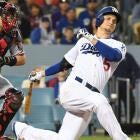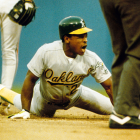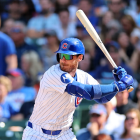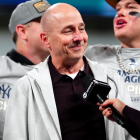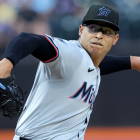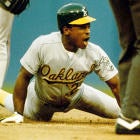The final day of the decade has arrived. The last 10 years of baseball brought us the end of the Cubs' 108-year World Series drought, the greatness of Mike Trout, a Giants mini-dynasty, the rise of tanking, and more great young players than I care to list. Baseball is overloaded with talent right now. The game has never been played at a higher level than it was during the 2010s.
Baseball, at least at the MLB level, changed quite a bit over the last 10 years. It's the same basic game (three outs in an inning, four bases for a run, etc.) but it is played a little differently and may look a little different as well. That's to be expected. Everything in life evolves over a 10-year period. Baseball is no different.
As we prepare to enter 2020 and the next decade of baseball, here are five statistical trends that defined the 2010s.
More strikeouts and fewer balls in play
For better or worse -- worse, I believe, but to each their own -- strikeouts rule the day in baseball. MLB has set a new record strikeout rate in 11 of the last 12 seasons, including again in 2019. Strikeouts and homers have a bit of a chicken or the egg relationship. Are hitters striking out more because they're trying to hit home runs? Or are they trying to hit homers because strikeouts are so prevalent and it's difficult to string together multiple hits to build a rally?
More strikeouts equals fewer balls in play and thus less action on the field, which can lead to long stretches where not a whole lot happens. Pitches are thrown and plate appearances are recorded, but these days it's not uncommon to go full innings between balls in play. Let's compare 2010, the first year of the decade, to 2019:
| Strikeout rate | Walk rate | Plate appearances that end with a ball in play | |
|---|---|---|---|
2010 | 18.5% | 8.5% | 72.2% |
2019 | 23.0% | 8.5% | 67.5% |
MLB's average walk rate has not changed in the last decade -- it did dip 7.6 percent in 2014, though it has since bounced back to where it was previously -- but the strikeout rate keeps going up. As a result, only two out of every three plate appearances end with a ball in play nowadays, give or take. Ten years ago it was nearly three out of every four. That's a huge difference.
The rise in strikeouts is not cyclical. The league strikeout rate has steadily increased throughout history. It was 18.5 percent 10 years ago, 16.4 percent 10 years before that, 14.8 percent 10 years before that, 12.5 percent 10 years before that, and on and on it goes. Sometimes you can wait for the other shoe to drop and things to return to normal, like home runs. There are have been short-term homer spikes all throughout history. That's cyclical.
That is not the case with strikeouts. They continue to climb and I think MLB has reached a breaking point. One out of every three plate appearances ending without a ball in play can make for a dull baseball watching experience, especially for young fans trying to get into the game. Fans crave action and yes, a big strikeout can be very exciting. Overall, more balls in play would be a positive.
I'm not sure how MLB goes about curbing the continually increasing strikeout rate (lower the mound? move it back?) but waiting for the strikeouts to self-correct is a bad idea. We have more than a century of data telling us strikeouts will only increase -- the trend continued in the 2010s -- and we're getting to the point where something should be done.
Defensive shifts become widespread
Defensive shifts have been around a very long time. Teams used to shift against Ted Williams way back in the day:
Fenway Park, July 16, 1946 - Two all-time greats, Bob Feller pitching to Ted Williams. Notice infield shift put on Williams by Indians, used for first time on him in previous game (7/14/46) by Cleveland's skipper Lou Boudreau. This shift would follow Williams rest of his career pic.twitter.com/IQht1wLyDJ
— Old-Time Baseball Photos (@OTBaseballPhoto) December 5, 2019
It wasn't until the 2010s that shifts became widespread, however. The Rays were the first to use them regularly during the Joe Maddon years, and eventually the rest of the league followed suit. Intuitively, shifting make perfect sense. Position your defenders where the batter is mostly likely to hit the ball. Easy peasy. The data available today is far better than what was available even 10 years ago, so teams are shifting with increasing precision.
These days you can't go more than an inning or two without seeing the shortstop -- or even the third baseman, depending on the team and the situation -- on the right side of second base. The four-man outfield is becoming a thing as well. Surely the decline in batting average -- the league hit .248 in 2018, the lowest since 1972 -- is tied to the shift, right? Well, not necessarily:
| Plate appearances with shift | BABIP with shift | BABIP without shift | |
|---|---|---|---|
2010 | 2.6 percent | .311 | .297 |
2019 | 44.6 percent | .301 | .296 |
The climb from 2.6 percent to 44.6 percent has been steady. It was 4.7 percent in 2012, 6.6 percent in 2013, 11.5 percent in 2014, on and on it went. The league BABIP, or batting average on balls in play (excludes homers because the defense can't make a play on them), has consistently been higher with the shift than without. The gap has shrunk in recent years but it still exists. The hitter gained about five points of BABIP when the shift was on in 2019. Weird! But also overly simplistic.
As Jeff Sullivan detailed at FanGraphs in 2017, hitters who pull the ball are being punished by the shift and hitters who go the other way are being rewarded. We all knew that, but it's always good when the numbers match the eye test. Sullivan found that ground balls in particular have been affected by shifts. Pulled grounders have a much lower BABIP now than they did at the start of the decade, while opposite field grounders have a higher BABIP. There's a trade-off.
Teams are willing to live with the occasional ground-ball single against the shift because they're preventing more pulled balls from going for hits, including into the corner or into the gap for extra bases. The overall numbers may not show much impact, but, on an individual level, the shift can be be a production crusher. Teams wouldn't do it if it didn't work. Expect to see not only more shifts in the 2020s, but more creative shifts as well.
More velocity, but fewer fastballs
Thanks to modern training methods, human evolution, and a general emphasis on velocity (among other things), pitchers throw harder now than ever before. Back in the day teams had maybe one or two guys each who could run their fastball up to 95 mph. Now it seems every team has a guy in their bullpen who can throw 100 mph, and 95 mph hardly gets you noticed.
The 2010s are the first decade with pitch tracking fully available. PitchFX launched in 2007 and was fully available for the first time in 2008. Statcast and Trackman have since taken the reigns. The data confirms two things. One, pitchers are throwing harder than ever. I mean, duh. We all knew that. And two, pitchers are throwing their fastballs less than they were 10 years ago.
| Average fastball velocity | Fastballs thrown | |
|---|---|---|
2010 | 91.4 mph | 63.0% |
2019 | 92.6 mph | 58.3% |
Seems counterintuitive, right? Pitchers are using their fastball less despite throwing harder than ever. Seems like you'd want to throw your fastball more when you have this much velocity, but that hasn't happened. Teams are scaling back on the heater.
The explanation is pretty simple: non-fastballs are harder to hit than fastballs. Sliders, curveballs, changeups, pretty much anything that moves is harder to square up than a fastball. That has been the case throughout history and remains true today. Here's how the league performed against various pitch types in 2019:
| Batting average | Slugging percentage | |
|---|---|---|
Fastballs | .274 | .476 |
Sliders | .217 | .380 |
Curveballs | .228 | .383 |
Changeups | .235 | .392 |
In a way, it is a bit surprising it took the league so long to catch on to the effectiveness of non-fastballs vs. fastballs. Non-fastballs are harder to hit than fastballs so teams are throwing them more, and some teams are taking it to the extreme. The Astros, arguably the smartest and most progressive team in the sport, threw less than 50 percent fastballs in 2019. For real.
Why don't pitchers throwing sliders and curveballs all the time then? A few reasons. For one, fastballs still help set up non-fastballs. The pitcher has to change the hitter's eye level and timing to keep him honest. Two, throw the same pitch too often and eventually hitters will catch up, not matter how good the pitch is. MLB hitters are crazy good. There's also a self-preservation component. It is generally believed that curveballs and sliders are bad for the arm. Throw too many of them and you're going to get hurt.
Like the rising strikeout rate, I do not believe the increase in velocity is cyclical. It'll continue going up. There may be a point where we reach the human body's limit when it comes to velocity, but gosh, who knows? Give it a few years or generations and 110 mph fastballs could be the norm. I doubt we'll see it during out lifetimes. I wouldn't rule it out though.
And unlike the rising strikeout rate, I do believe the decrease in fastballs thrown is cyclical. That's a pendulum I can see swinging back the other way at some point, maybe even soon. Velocity is a skill that can be improved. Pitch selection is a strategy that is constantly tweaked to achieve success.
The decline in stolen bases
Do you know who led MLB in stolen bases in 2019? I didn't. I had to look it up. It was Mariners outfielder Mallex Smith with 47. Ronald Acuna Jr. led the National League with 37 -- 37! -- steals. It was the lowest stolen base total for the NL leader since Maury Wills had 35 in 1961. Wills made up for it by stealing 104 bags in 1962. Acuna's awesome, but I'd bet against him doing that.
The stolen base is a dying art. Only eight players stole 30 bases in 2019. Ten years ago 19 players did it. Over the last decade stolen bases have declined and stolen base attempt rate has decline, but stolen base success rate has slightly improved. Players are much better at picking their spots to steal a bag.
| Stolen bases | Stolen base attempt rate | Stolen base success rate | |
|---|---|---|---|
2010 | 2,959 | 6.0% | 72.4% |
2019 | 2,280 | 4.7% | 73.2% |
"Analytics" has become a crutch word, a catch-all term for things people don't understand, but the decline of the stolen base can be blamed squarely on analytics. The numbers say the risk is often not worth the potential reward, especially in an era when so many home runs are being hit. Why risk losing a baserunner when the next batter, whomever it is, could put the ball in the seats?
I believe the stolen base will return to prominence at some point in the future but not back to where it was in the 1980s. At the end of the day, the math does say stolen bases are risky, and teams will continue to limit their risk and pick their spots. Eventually the ball will stop flying out of the park like it does now though, and, when that happens, the stolen base will become more valuable. Over the last decade, the stolen base took a backseat. It is a secondary option.
Pace of play
Commissioner Rob Manfred's three favorite words. And you know what? He's right to want to improve pace of play. Attention spans are shorter than ever and there needs to be action to draw in younger fans. The pace of baseball grew worse in the 2010s:
| Average time per 9 innings | Average pace (between pitches in an at-bat) | |
|---|---|---|
2010 | 2 hours, 50 minutes | 21.5 seconds |
2019 | 3 hours, 5 minutes | 24.4 seconds |
Pace is the time between pitches within an at-bat. On average, we wait about three seconds longer between pitches now than we did 10 years ago. That is untenable. The average time of game has gone up 15 minutes and I don't think that's a problem. Long games are fine as long as there's action. It's a downtime within the game that is the problem. There's too much standing around and not enough baseballing.
MLB has implemented several pace of play initiatives to varying levels of success in recent years. Forcing hitters to stay in the box after taking a pitch was a total failure. Reducing mound visit has worked very well. No one misses those. I am pro pitch clock. I don't think a 20-second pitch clock with the bases empty is too much to ask. There is a 20-second pitch clock in Double-A and Triple-A, so many players are already used to it. The adjustment would be quick.
Manfred & Co. will continue to focus on pace of play and they should. The more downtime within a game, the more fans will look at their phones and the more young kids will look for something else to do. I expect a pitch clock to arrive at some point during the next decade and I hope it's sooner rather than later. I love this stupid sport, but damn, it can take a long time for not much to happen.








